Hampi in Karnataka, India is an UNESCO site, a site of rich heritage of sculpture, architecture, culture and history. Hampi, the glorious capital of the great Vijayanagara empire.The area of about 26 sq, Km. is studded with ruins of temples, small and grand temples. Many of these are restored to great extent and others might have been buried under the ground completely destroyed.
Among this large bevy of magnificent temples Virupaksha temple holds a special place due to many reasons.
Virupaksha temple , we can trace it back to our mythological references. Hemkuta hills on which this temple is located is said to be the place where Lord Shiva was doing his penance[ tapsya, dhyan] when Kamdev, God of love disturbed Him in order to help the local girl Pampa who was deeply in love with the lord and wanted to marry Him. Pampa was ultimately successful in impressing Lord by her severe penance and deep devotion and He agreed to marry her but in the process Kamdev had to bear the burnt of Shivas anger and that too literally. Shiva opened His third eye in anger and Kamdev turned into ashes. So here Shiva opened His third eye. Does it have any relation with Shiva being worshiped here as Virupaaksha? Aksha means eye, Virup means formless- formless eye. In deeper sense it refers to consciousness -- seeing without eyes, feeling without skin, means absorbing everything without the help of sense organs and that is the state of yoga samidhi. On these hills Shiva was in samadhi awastha.
The recorded history of this temple is from seventh century A.D. Inscriptions from ninth century are still there in temple premises. The inner sanctum of temple is older than the Vijayanagara empire. This temple has a history of active worship of more than 2000 years.It is believed that despite various attacks, destruction of mighty Vijayanagar empire, ravages of Hampi in the hands of time, the puja, archna in the temple continued uninterrupted. This in itself is very reassuring. It strengthens our faith in the Super being, the divine entity.
Exterior of temple----The east facing gate is the main gate of the temple. In front of it is about one kilometer long bazar with shops on both the sides of wide path. The lines of colonnaded shop reflect on the great planning skills of the people in power at that time. At the end of the Bazar there sits a giant monolithic Nandi on high platform facing the temple. In Lepakshi too the big monolithic Nandi sits about a kilometer away from Virupaksha temple. What could have been the thought behind this? Why Nandis were not made just in front of the temples or inside the temples? In Brihdeshwara, Tanjore too the Nandi idol is mammoth but it is inside the temple. Though placed under a separate canopy, on a separate high raised platform but inside temple premises just outside the door leading to Garbhgrah but in these two Virupaksha temples they are placed at a distance. Does it have anything to do with this particular form of Shiva?
Gopuram of Virupaksha temple - The gopura on the bazar side was under renovation when we visited Hampi. However even the horizontally, vertically rods fitted all around the lofty gopura were not able to mar the grandeur, the majesty of the nine storied gopura. Another gopura is on the tank side. This too is built almost in the same style and grandeur. The progressively narrowing figure of gopuram is built of brick and mortar. there are exquisitely sculpted characters and figures on the lower tiers of the nine story Gopuram. In every storey in the middle is a small door like open structure. Somebody told that there is provision of going to the top of the Gopuram, May be there are stairs inside the structure. Not sure about that. just a thought. On the top of Gopuram there are two horn like projections at each end and in the middle is placed Kalash.

The shape of Gopuram always remind me of hands with folded palms. The entire structure as if speaks on behalf of us.... we send our reverential salutations to Almighty, up there.
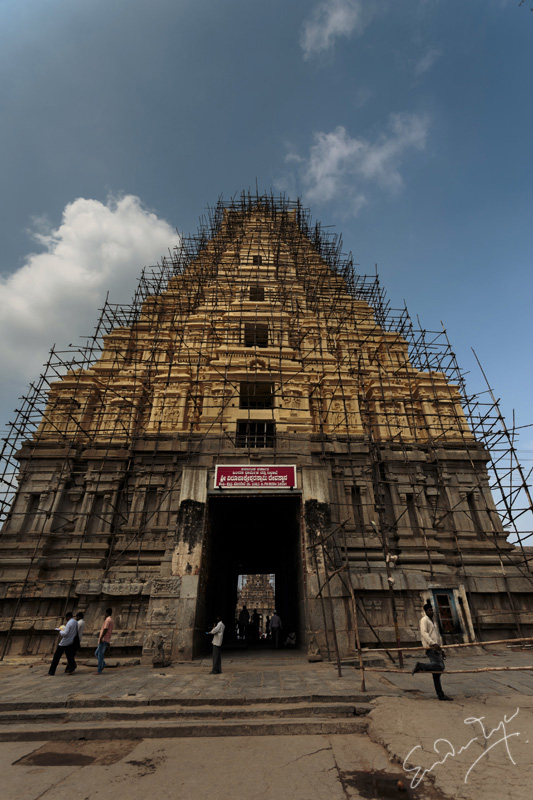

This is Kanakgiri gopura side of the temple, the holy tank side of the temple. I spent an evening on it's bank. The still waters of the tank with reflection of Gopura nestled close to it's heart appeared to say a clear heart is the abode of the sacred and pious entities. How pacifying and calming was it's impact. Far and wide the distant blue horizon invited one to drop all the binding chains and soar high with stretched wings and light heart to pastures unknown. The deep waters of tank locked the gaze and took it deep up to the core of the being. These are the moments when I forget that I exist.
Kalyan Madapam

This Mandapam in the temple courtyard with carved pillars and painted ceiling is an exquisite example of the impeccable skills of artists of the Vijayanagar empire period. This mandapam is said to be the contribution of one of the most famous king of Vijayanagar empire, Krishnadeva Raya. It is known as Kalyan Mandapam or Rang Mandapam. The mythological figures carved on the pillars, the carving on the panels above the pillars and the colourful depiction of various mythological anecdotes leave one spellbound.Such treasures of our rich heritage not only fascinate us but prompt us to explore more, to learn more, to go deeper.
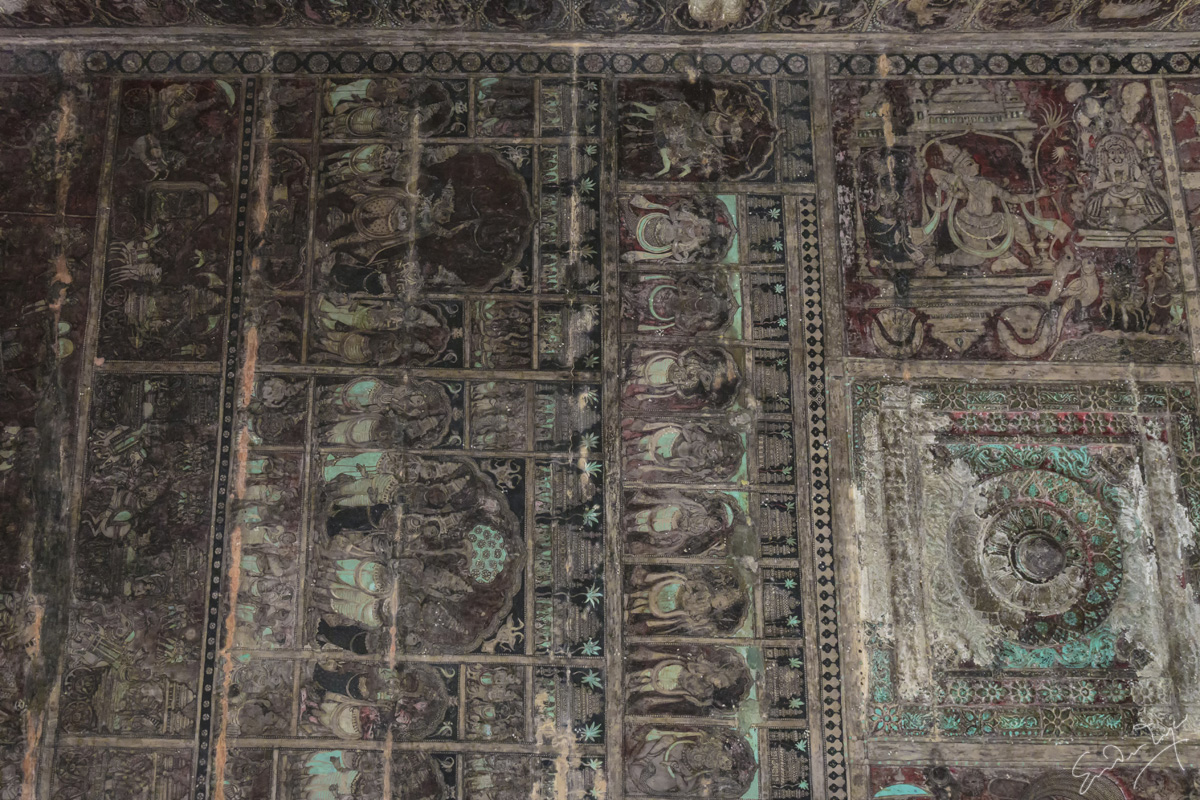
A closure look of the paintings on the ceiling of the mandapam. The colours still retain their brightness though centuries have passed.
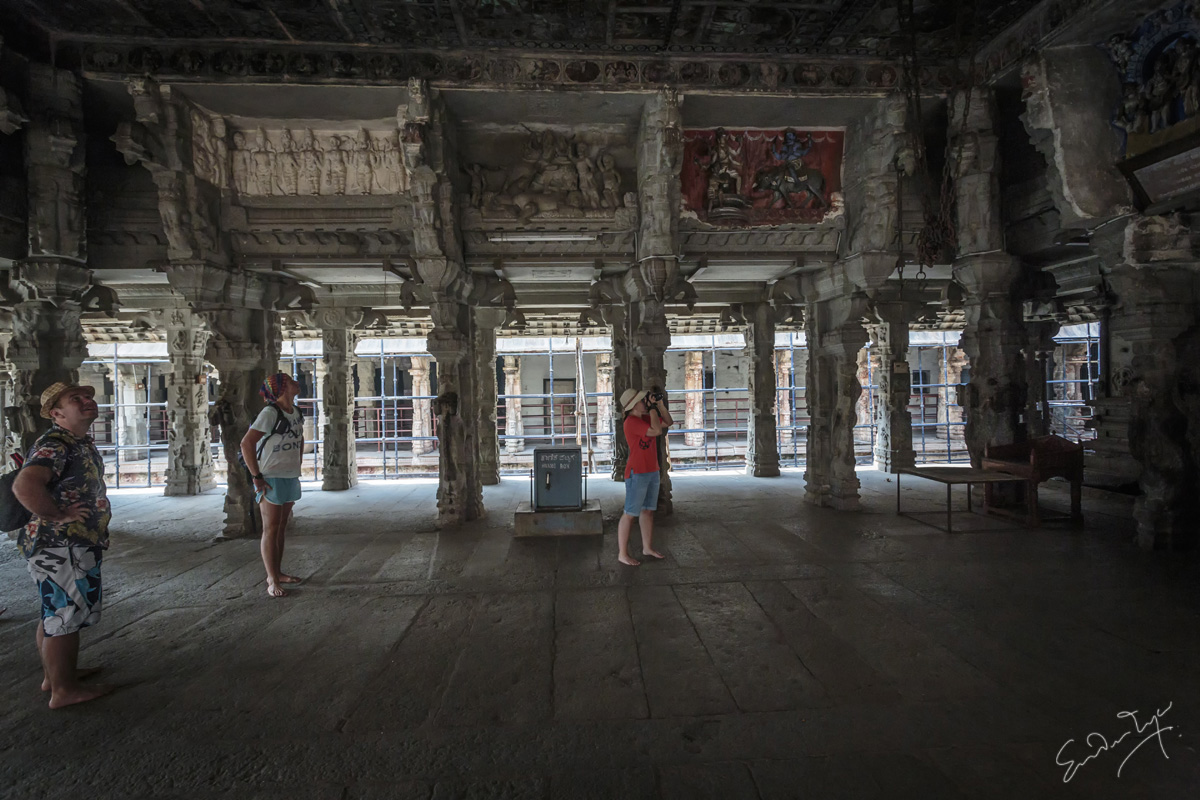
Another look of the Kalyan Madapam
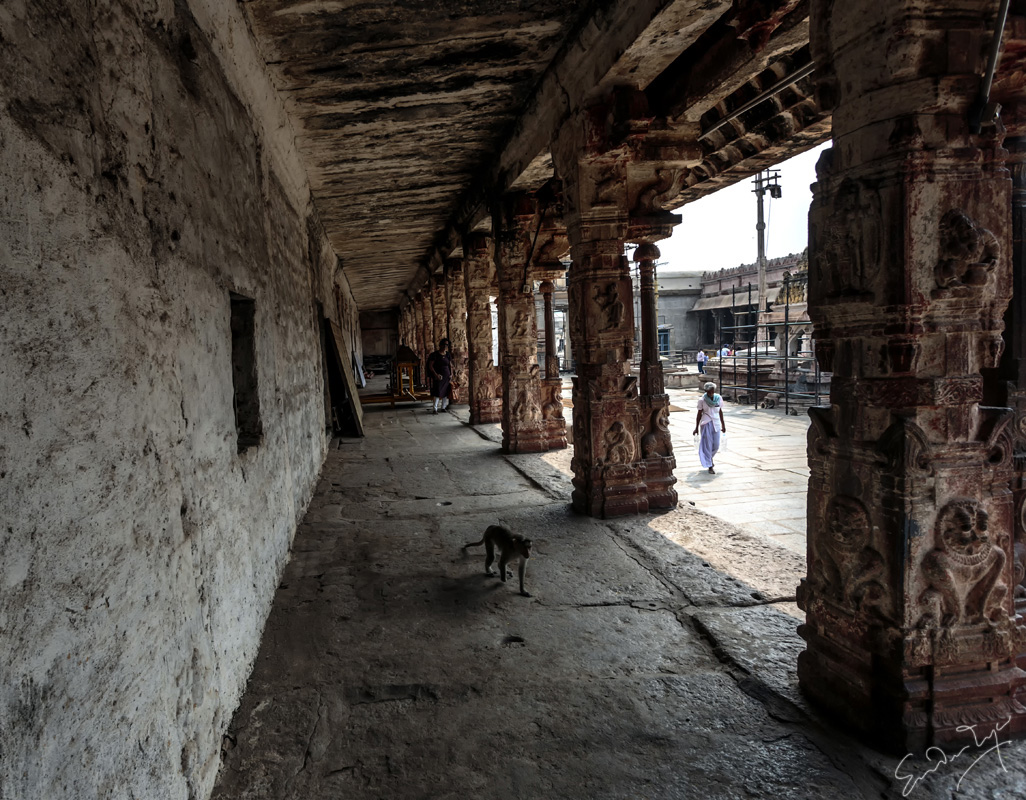

Second Courtyard
A small three tiered gopura leads us to the second courtyard of the temple. The outer and the first courtyard houses architecturally beautiful structures but this second courtyard houses the soul of the temple. Not only the main shrines of Virupaksha Shiva, the consort of the local goddess Pampa[ pampa is associated with river Tungbhadra] but also many shrines are fitted in between the collonaded pathway encircling the courtyard. Even when the day is sparkling blue and gold outside certain niches and antechambers in this section are dusky with some sun rays filtering in at some places. A small shrine tucked in the wall, a lone deepak burning steady, devotees sitting here and there engrossed in their own inside world-- the entire area pulsate with deep positive energy. You sit quietly with your eyes closed for few minutes and the murmurs of tourists gradually turns into whispers and then a complete silence engulfs you and a little blue glow suffused your inside. The pervading energy makes you feel secured and protected , a feeling of being in womb.
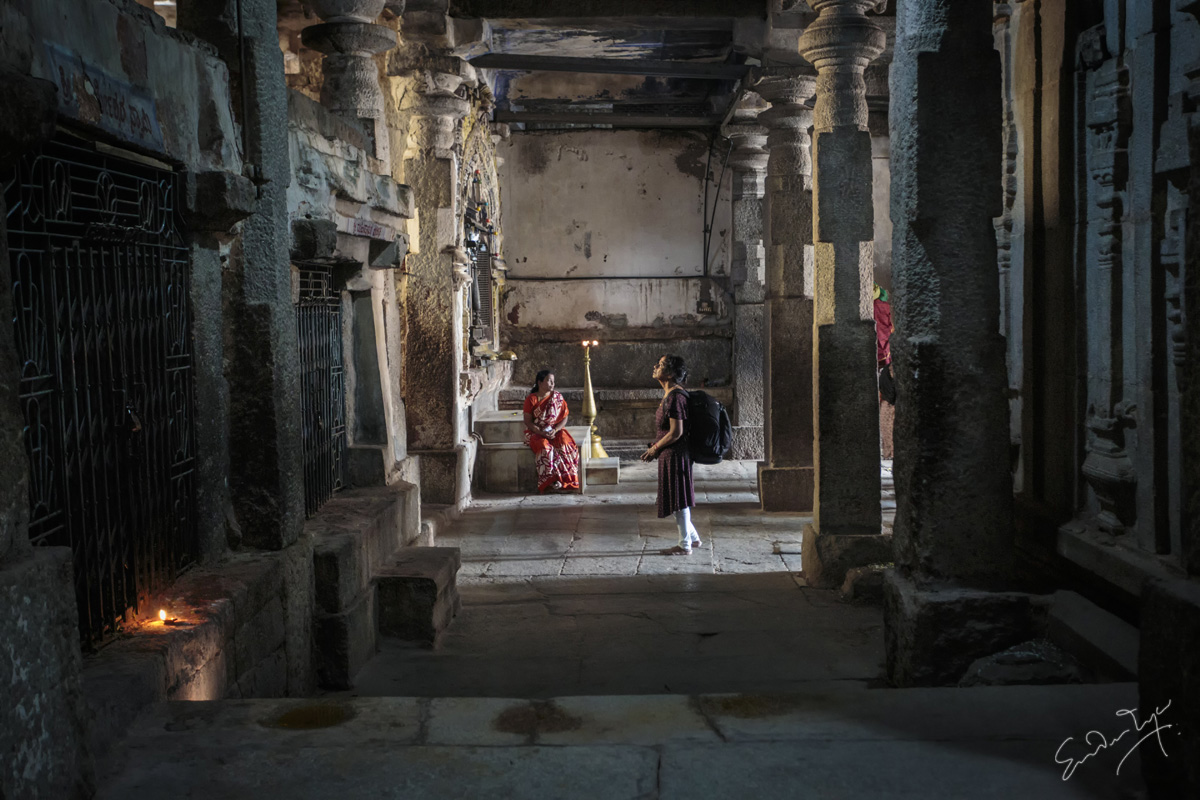

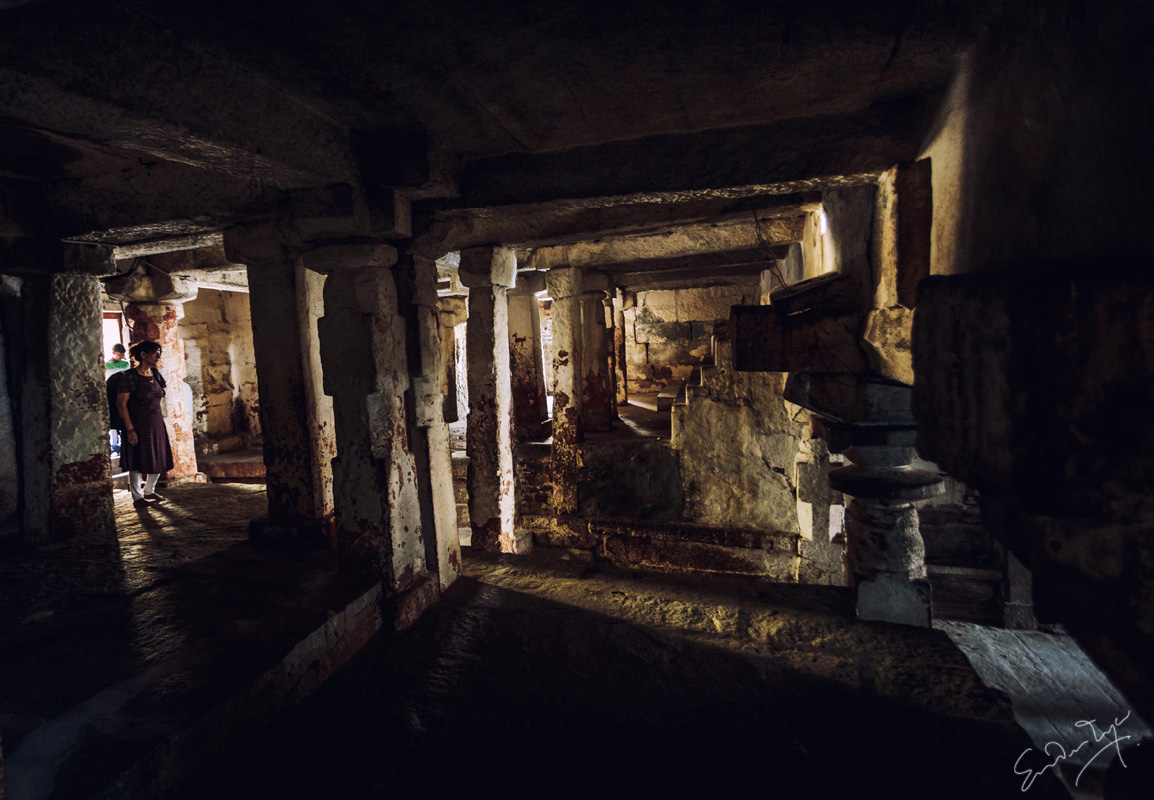
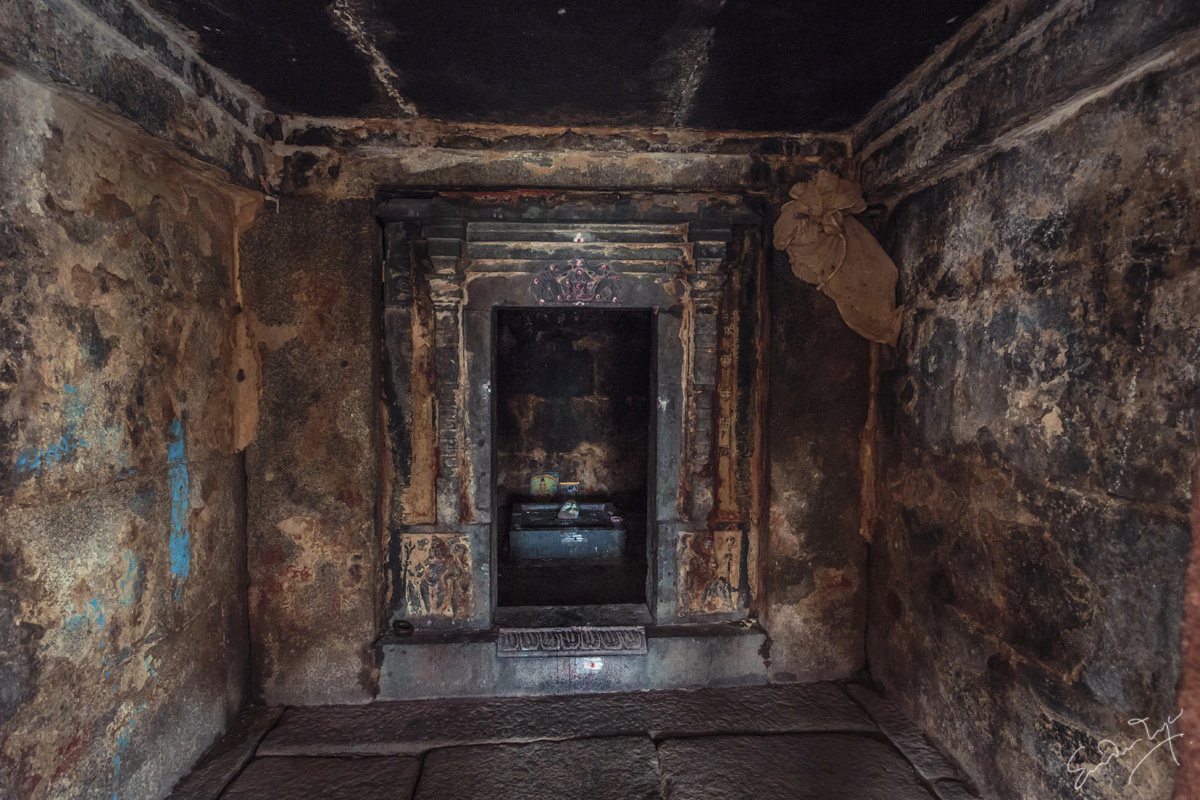
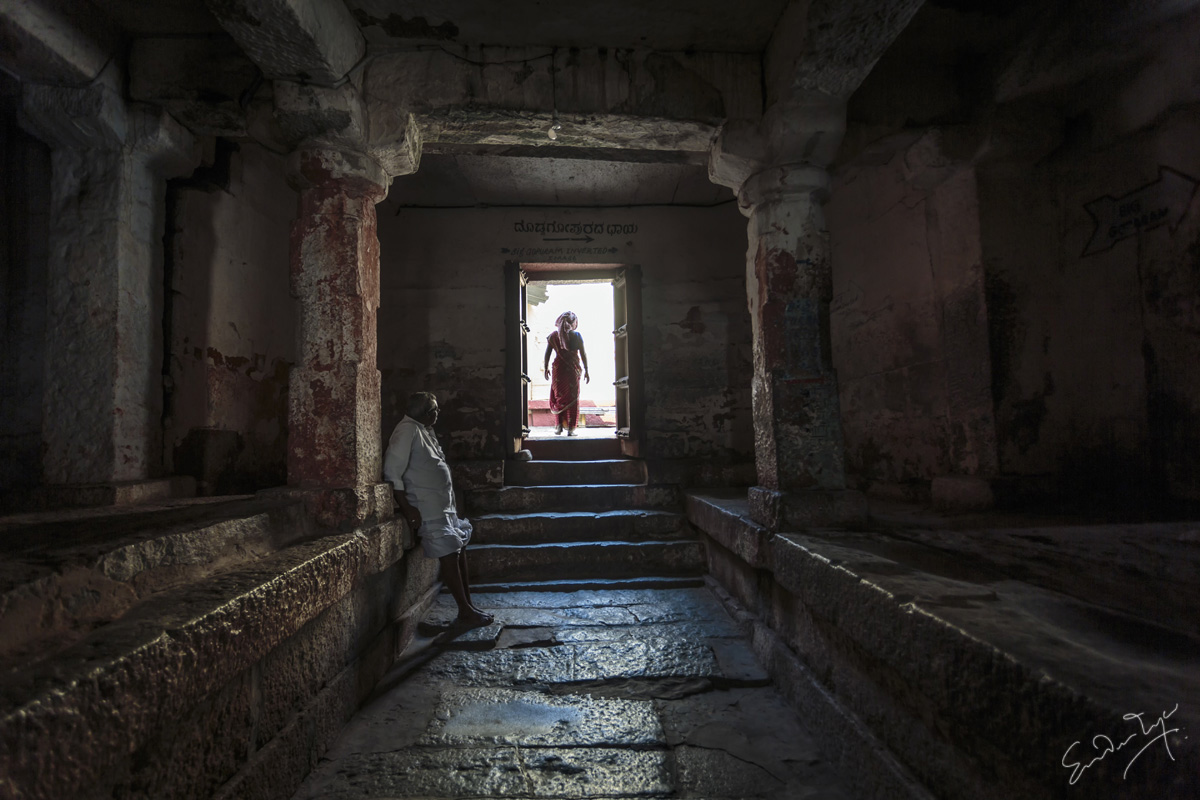
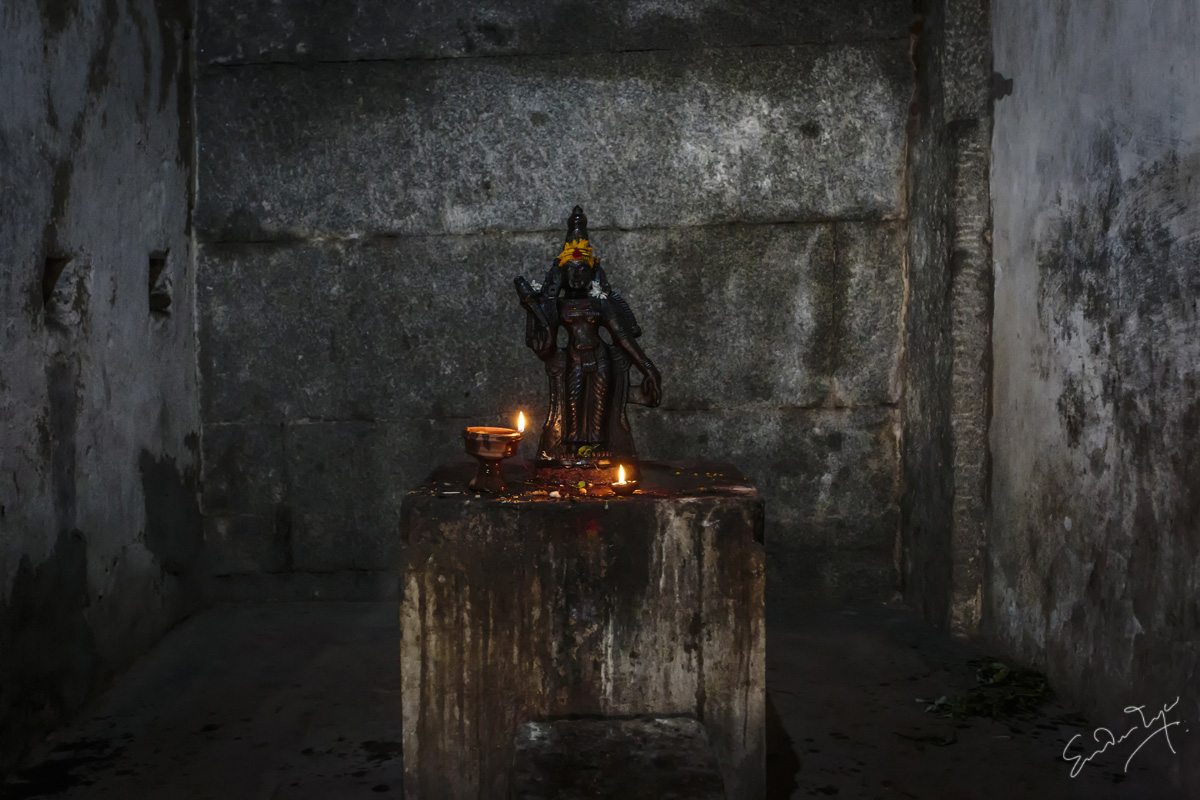


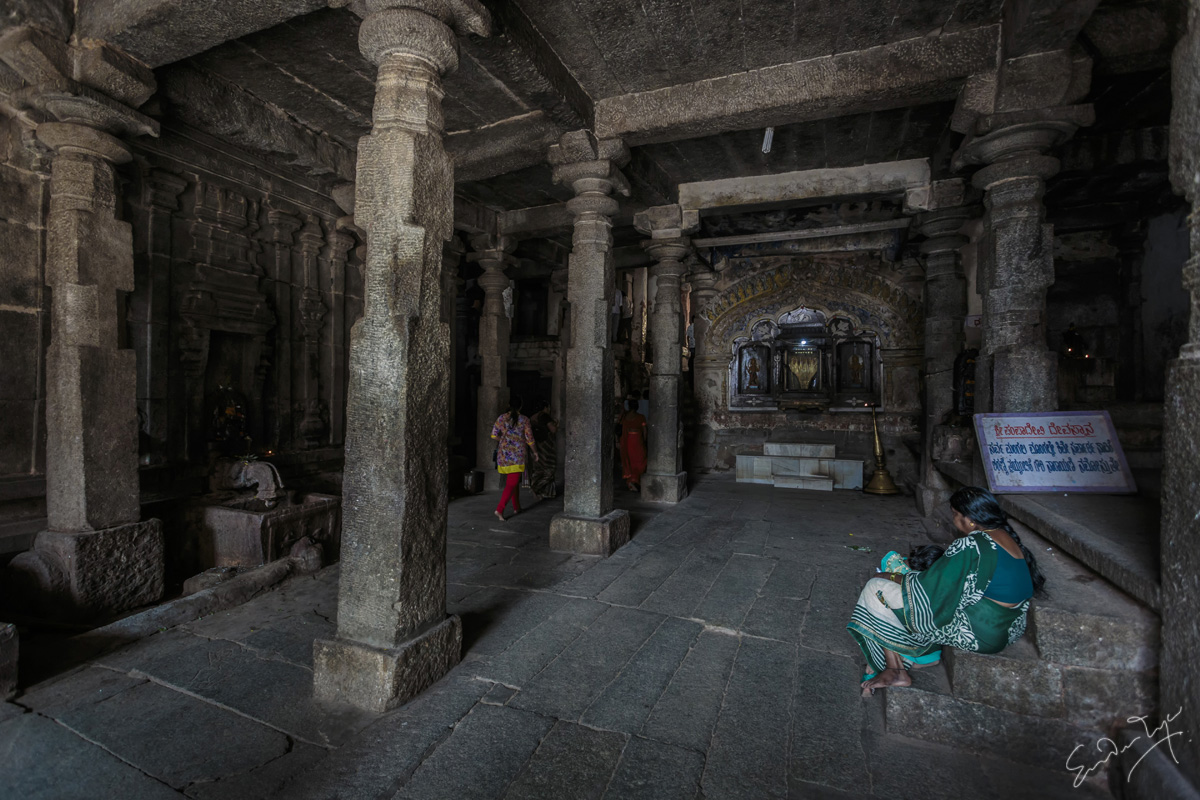
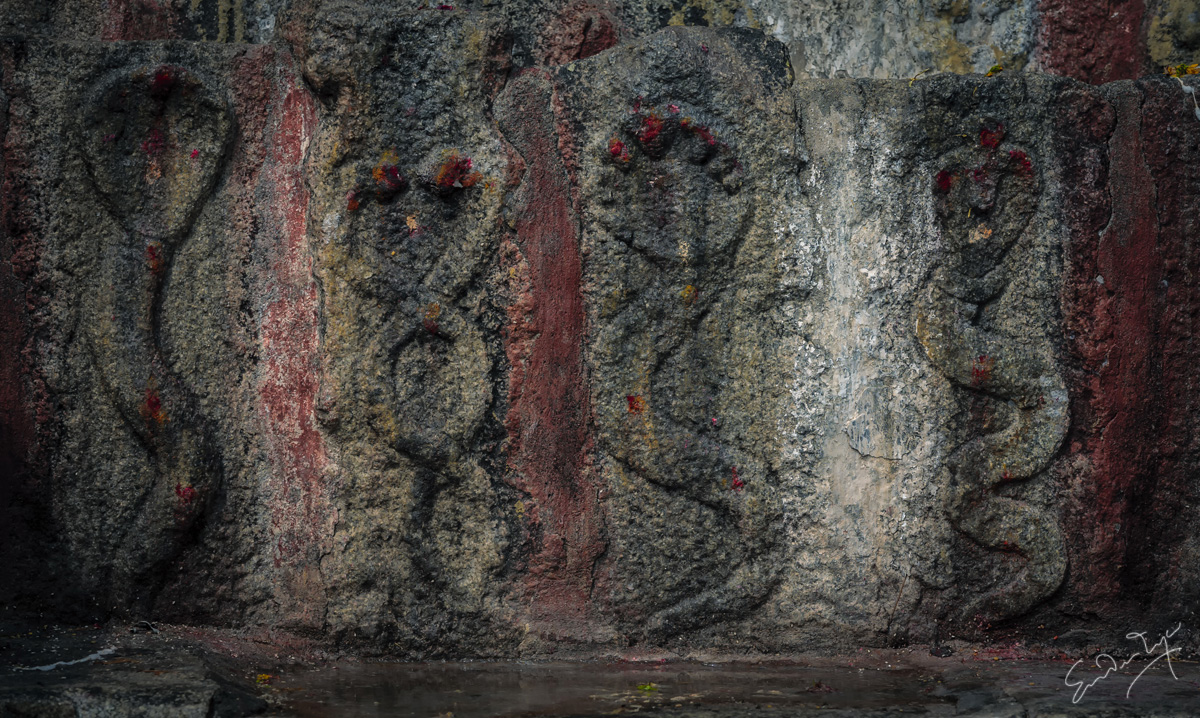
Some other deities are Bhuvaneshwari, Pataleshwara, Navgrah, Nagas, and Ganesha, Hanumana
There are some shrines outside Kanakgiri Gopura, on the side of tank.
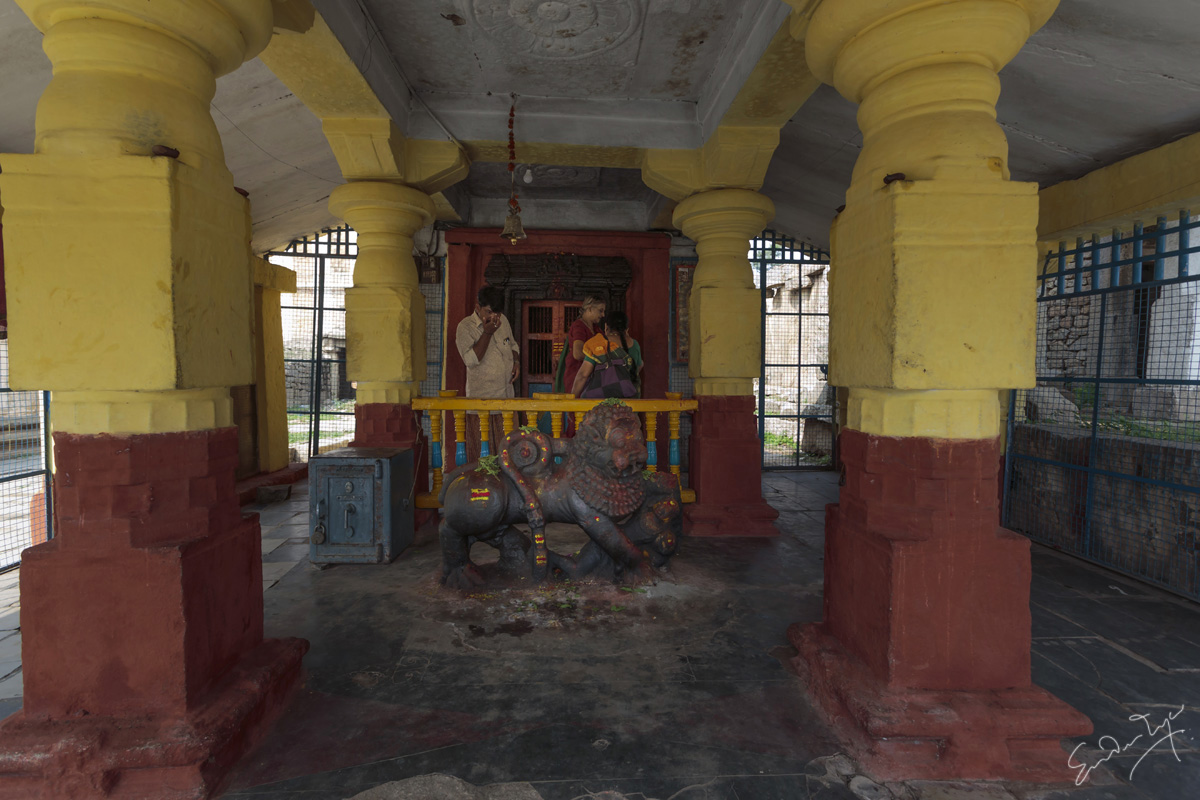
The inverted shadow image of the gopura on the wall of one of the ante image is another attraction of the temple. The pin hole camera effect.The shadow falls on the wall which is close to the rear end of the temple, quite far away from the entry gopura.

Another special feature of the temple is a big kitchen and the water connectivity system here. Water from river Tungbhadra was carried directly to the the temple kitchen through underground canal system. I am not very sure whether the system is functional presently or not but the network of pipelines can be seen.
The annual chariot festival celebrated in February every year and marriage festivity activities of Virupaksha and Pampa too take place with great fervor.
Visiting Virupaksha temple at Hampi was an enriching experience for me in more than one way. It took me back to glorious pages of history of my land, my race and strengthened my being like that tree whose roots go deep inside earth and it faces the rough weather with faith on bonds that hold it firmly.
All the pictures by Sunder Iyer
Among this large bevy of magnificent temples Virupaksha temple holds a special place due to many reasons.
Virupaksha temple , we can trace it back to our mythological references. Hemkuta hills on which this temple is located is said to be the place where Lord Shiva was doing his penance[ tapsya, dhyan] when Kamdev, God of love disturbed Him in order to help the local girl Pampa who was deeply in love with the lord and wanted to marry Him. Pampa was ultimately successful in impressing Lord by her severe penance and deep devotion and He agreed to marry her but in the process Kamdev had to bear the burnt of Shivas anger and that too literally. Shiva opened His third eye in anger and Kamdev turned into ashes. So here Shiva opened His third eye. Does it have any relation with Shiva being worshiped here as Virupaaksha? Aksha means eye, Virup means formless- formless eye. In deeper sense it refers to consciousness -- seeing without eyes, feeling without skin, means absorbing everything without the help of sense organs and that is the state of yoga samidhi. On these hills Shiva was in samadhi awastha.
The recorded history of this temple is from seventh century A.D. Inscriptions from ninth century are still there in temple premises. The inner sanctum of temple is older than the Vijayanagara empire. This temple has a history of active worship of more than 2000 years.It is believed that despite various attacks, destruction of mighty Vijayanagar empire, ravages of Hampi in the hands of time, the puja, archna in the temple continued uninterrupted. This in itself is very reassuring. It strengthens our faith in the Super being, the divine entity.
Exterior of temple----The east facing gate is the main gate of the temple. In front of it is about one kilometer long bazar with shops on both the sides of wide path. The lines of colonnaded shop reflect on the great planning skills of the people in power at that time. At the end of the Bazar there sits a giant monolithic Nandi on high platform facing the temple. In Lepakshi too the big monolithic Nandi sits about a kilometer away from Virupaksha temple. What could have been the thought behind this? Why Nandis were not made just in front of the temples or inside the temples? In Brihdeshwara, Tanjore too the Nandi idol is mammoth but it is inside the temple. Though placed under a separate canopy, on a separate high raised platform but inside temple premises just outside the door leading to Garbhgrah but in these two Virupaksha temples they are placed at a distance. Does it have anything to do with this particular form of Shiva?
Gopuram of Virupaksha temple - The gopura on the bazar side was under renovation when we visited Hampi. However even the horizontally, vertically rods fitted all around the lofty gopura were not able to mar the grandeur, the majesty of the nine storied gopura. Another gopura is on the tank side. This too is built almost in the same style and grandeur. The progressively narrowing figure of gopuram is built of brick and mortar. there are exquisitely sculpted characters and figures on the lower tiers of the nine story Gopuram. In every storey in the middle is a small door like open structure. Somebody told that there is provision of going to the top of the Gopuram, May be there are stairs inside the structure. Not sure about that. just a thought. On the top of Gopuram there are two horn like projections at each end and in the middle is placed Kalash.

The shape of Gopuram always remind me of hands with folded palms. The entire structure as if speaks on behalf of us.... we send our reverential salutations to Almighty, up there.


This is Kanakgiri gopura side of the temple, the holy tank side of the temple. I spent an evening on it's bank. The still waters of the tank with reflection of Gopura nestled close to it's heart appeared to say a clear heart is the abode of the sacred and pious entities. How pacifying and calming was it's impact. Far and wide the distant blue horizon invited one to drop all the binding chains and soar high with stretched wings and light heart to pastures unknown. The deep waters of tank locked the gaze and took it deep up to the core of the being. These are the moments when I forget that I exist.
Kalyan Madapam

This Mandapam in the temple courtyard with carved pillars and painted ceiling is an exquisite example of the impeccable skills of artists of the Vijayanagar empire period. This mandapam is said to be the contribution of one of the most famous king of Vijayanagar empire, Krishnadeva Raya. It is known as Kalyan Mandapam or Rang Mandapam. The mythological figures carved on the pillars, the carving on the panels above the pillars and the colourful depiction of various mythological anecdotes leave one spellbound.Such treasures of our rich heritage not only fascinate us but prompt us to explore more, to learn more, to go deeper.

A closure look of the paintings on the ceiling of the mandapam. The colours still retain their brightness though centuries have passed.

Another look of the Kalyan Madapam


Second Courtyard
A small three tiered gopura leads us to the second courtyard of the temple. The outer and the first courtyard houses architecturally beautiful structures but this second courtyard houses the soul of the temple. Not only the main shrines of Virupaksha Shiva, the consort of the local goddess Pampa[ pampa is associated with river Tungbhadra] but also many shrines are fitted in between the collonaded pathway encircling the courtyard. Even when the day is sparkling blue and gold outside certain niches and antechambers in this section are dusky with some sun rays filtering in at some places. A small shrine tucked in the wall, a lone deepak burning steady, devotees sitting here and there engrossed in their own inside world-- the entire area pulsate with deep positive energy. You sit quietly with your eyes closed for few minutes and the murmurs of tourists gradually turns into whispers and then a complete silence engulfs you and a little blue glow suffused your inside. The pervading energy makes you feel secured and protected , a feeling of being in womb.










Some other deities are Bhuvaneshwari, Pataleshwara, Navgrah, Nagas, and Ganesha, Hanumana
There are some shrines outside Kanakgiri Gopura, on the side of tank.

The inverted shadow image of the gopura on the wall of one of the ante image is another attraction of the temple. The pin hole camera effect.The shadow falls on the wall which is close to the rear end of the temple, quite far away from the entry gopura.

Another special feature of the temple is a big kitchen and the water connectivity system here. Water from river Tungbhadra was carried directly to the the temple kitchen through underground canal system. I am not very sure whether the system is functional presently or not but the network of pipelines can be seen.
The annual chariot festival celebrated in February every year and marriage festivity activities of Virupaksha and Pampa too take place with great fervor.
Visiting Virupaksha temple at Hampi was an enriching experience for me in more than one way. It took me back to glorious pages of history of my land, my race and strengthened my being like that tree whose roots go deep inside earth and it faces the rough weather with faith on bonds that hold it firmly.
All the pictures by Sunder Iyer